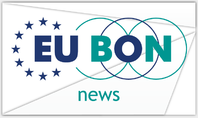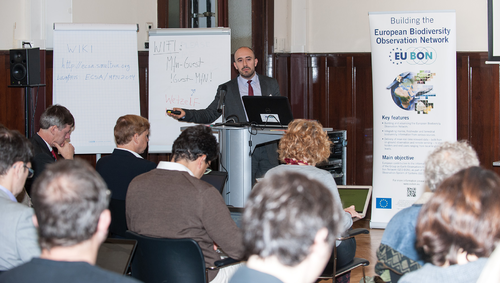
The second EU BON Roundtable took place on 27 November 2014 at the Museum für Naturkunde in Berlin. The workshop was dedicated to explore ways in which EU BON can support citizen science (CS) activities. Many partners and interested stakeholders participated, coming from different European research institutions, Natural History Museums, SMEs or representatives from European Institutions like European Commission (DG Research & Innovation and the Joint Research Centre) or the European Environmental Agency and EU-funded Citizen Observatories projects. On secondment to the Earth Observation Sector at DG Research and Innovation, European Commission, Jose-Miguel Rubio-Iglesias showed the possibilities of Citizen Science as one option to improve the science-society bridge. In the following interview he gives an overview of the topic covered and his participation at the round table.

Jose-Miguel Rubio-Iglesias gave a talk on improving the science-society-policy bridge by Citizen Science
Jose-Miguel Rubio-Iglesias, Policy Officer (Spanish National Centre for Geographic Information, on secondment to the European Commission)
Q: Where do you see the place of citizen science in the future of European research and innovation efforts?
A: I see a brilliant future of Citizen Science as a driver for research and innovation activities, especially in its shape of "Citizens' Observatories". The vertiginous increase in the use of mobile technologies, with a pervasive Internet accessible to everyone and social media usage at its peak, offers a world of opportunities for research and innovation in the domain of environmental monitoring technologies where citizens have a key role to play. Citizen science can also foster advancement in social innovation as these are normally collective actions carried out by citizens, sometimes in partnership with NGOs, researchers and public organisations, which are bringing benefits for the whole society. Furthermore, the European Union's Framework Programme for Research and Innovation, Horizon 2020, is already offering a framework to mainstream public engagement in science and research, from programming to implementation and evaluation, being citizen science a one of the key instruments to realise this objective. Data and information gathering, results interpretation and co-creation are examples of activities in which citizens can be involved, leading to different kinds of innovation, including social innovation.
Q: What are the success factors for citizen science? What are the challenges for Citizen Science on a European scale?
A: In my opinion there is no magic formula to achieve success in a citizen science activity, nor any plug-and-play solution. There are many variables that have to be considered, such as the thematic, spatial or temporal scope of the activity. But a common element that seems to be an ingredient for success is to plan carefully not only the process of engagement but the feedback mechanisms, so citizens realise their actions and the outcomes of what they have done are really being useful. Working on creating a strong perception of ownership is always a success factor on a voluntary initiative.
I see a number of challenges for Citizen Science at a European scale, especially, the need for a better coordination of the local and regional activities. This can avoid duplication of initiatives, foster best practices across activities and help position better citizen science vis-à-vis the EU and national and local governments, so citizen science can be higher up on their agendas. In this sense, I think the role of associations such as ECSA (European Citizen Science Association) is key in achieving this coordination.
Q: How can EU projects on biodiversity information like EU BON facilitate the process?
A: EU BON, like other EU projects which have biodiversity information as a focus, has an important role to make visible the knowledge treasured by citizen science groups. The European Biodiversity Portal, one of the EU BON main achievements, is a fantastic opportunity to open up the wealth of biodiversity data which has been collected by citizens throughout Europe, making it available for a better informed decision making in those areas in which biodiversity has a role.
Q: Where do you see the place of large European Earth observation projects such as EU BON in the global context?
A: The biodiversity information system resulting from EU BON is one of the main European contributions to GEO BON (GEO Biodiversity Observation Network), which is a flagship initiative of GEO (Group on Earth Observation). GEO BON is joining forces at international level to coordinate the activities relating to the Societal Benefit Area on Biodiversity of the Global Earth Observation System of Systems (GEOSS). Its main goals are to organize and improve terrestrial, freshwater and marine biodiversity observations globally and make their biodiversity data, information and forecasts more readily accessible to policymakers, managers, experts and other users. As EU BON is creating a stable and open-access platform for sharing biodiversity tools and data, taking stock of existing components such as LifeWatch or GBIF, this is clearly a step forward towards the fulfilment of the objectives of GEO BON.
At global level, EU BON and GEOBON are strategically positioned to contribute to delivery of data for the UN Convention on Biological Diversity (CBD) and the Intergovernmental Science-Policy Platform on Biodiversity and Ecosystem Services (IPBES).
Finally, together with EU BON, other large EU Earth Observation projects, such as SIGMA or Earth2Observe, are also providing an important contribution at global level to GEO, in this case to the GEO Societal Benefit Areas of Agriculture (GEO-GLAM) and Water respectively.
NOTE: The views expressed in this interview are only of the speaker and do not necessarily reflect the official opinion of the European Commission.




 RSS news
RSS news Print this article
Print this article
